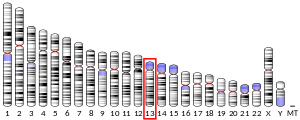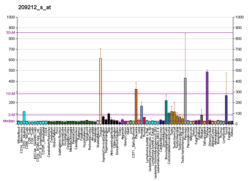KLF5
Krueppel-like factor 5 is a protein that in humans is encoded by the KLF5 gene.[4][5]
Function
This gene encodes a member of the Kruppel-like factor subfamily of zinc finger proteins. Since the protein localizes to the nucleus and binds the epidermal growth factor response element, it is thought to be a transcription factor.[5]
Interactions
KLF5 has been shown to interact with Protein SET.[6]
See also
References
- GRCh38: Ensembl release 89: ENSG00000102554 - Ensembl, May 2017
- "Human PubMed Reference:". National Center for Biotechnology Information, U.S. National Library of Medicine.
- "Mouse PubMed Reference:". National Center for Biotechnology Information, U.S. National Library of Medicine.
- Sogawa K, Imataka H, Yamasaki Y, Kusume H, Abe H, Fujii-Kuriyama Y (Apr 1993). "cDNA cloning and transcriptional properties of a novel GC box-binding protein, BTEB2". Nucleic Acids Research. 21 (7): 1527–32. doi:10.1093/nar/21.7.1527. PMC 309358. PMID 8479902.
- "Entrez Gene: KLF5 Kruppel-like factor 5 (intestinal)".
- Miyamoto S, Suzuki T, Muto S, Aizawa K, Kimura A, Mizuno Y, Nagino T, Imai Y, Adachi N, Horikoshi M, Nagai R (Dec 2003). "Positive and negative regulation of the cardiovascular transcription factor KLF5 by p300 and the oncogenic regulator SET through interaction and acetylation on the DNA-binding domain". Molecular and Cellular Biology. 23 (23): 8528–41. doi:10.1128/MCB.23.23.8528-8541.2003. PMC 262669. PMID 14612398.
Further reading
- Ghaleb AM, Nandan MO, Chanchevalap S, Dalton WB, Hisamuddin IM, Yang VW (Feb 2005). "Krüppel-like factors 4 and 5: the yin and yang regulators of cellular proliferation". Cell Research. 15 (2): 92–6. doi:10.1038/sj.cr.7290271. PMC 1317089. PMID 15740636.
- Nagai R, Suzuki T, Aizawa K, Shindo T, Manabe I (Aug 2005). "Significance of the transcription factor KLF5 in cardiovascular remodeling". Journal of Thrombosis and Haemostasis. 3 (8): 1569–76. doi:10.1111/j.1538-7836.2005.01366.x. PMID 16102021.
- McConnell BB, Ghaleb AM, Nandan MO, Yang VW (Jun 2007). "The diverse functions of Krüppel-like factors 4 and 5 in epithelial biology and pathobiology". BioEssays. 29 (6): 549–57. doi:10.1002/bies.20581. PMC 2211634. PMID 17508399.
- Kojima S, Kobayashi A, Gotoh O, Ohkuma Y, Fujii-Kuriyama Y, Sogawa K (Feb 1997). "Transcriptional activation domain of human BTEB2, a GC box-binding factor". Journal of Biochemistry. 121 (2): 389–96. doi:10.1093/oxfordjournals.jbchem.a021600. PMID 9089417.
- Conkright MD, Wani MA, Anderson KP, Lingrel JB (Mar 1999). "A gene encoding an intestinal-enriched member of the Krüppel-like factor family expressed in intestinal epithelial cells". Nucleic Acids Research. 27 (5): 1263–70. doi:10.1093/nar/27.5.1263. PMC 148310. PMID 9973612.
- Shi H, Zhang Z, Wang X, Liu S, Teng CT (Dec 1999). "Isolation and characterization of a gene encoding human Kruppel-like factor 5 (IKLF): binding to the CAAT/GT box of the mouse lactoferrin gene promoter". Nucleic Acids Research. 27 (24): 4807–15. doi:10.1093/nar/27.24.4807. PMC 148782. PMID 10572182.
- Hoshino Y, Kurabayashi M, Kanda T, Hasegawa A, Sakamoto H, Okamoto E, Kowase K, Watanabe N, Manabe I, Suzuki T, Nakano A, Takase S, Wilcox JN, Nagai R (Nov 2000). "Regulated expression of the BTEB2 transcription factor in vascular smooth muscle cells: analysis of developmental and pathological expression profiles shows implications as a predictive factor for restenosis". Circulation. 102 (20): 2528–34. doi:10.1161/01.cir.102.20.2528. PMID 11076828.
- Sun R, Chen X, Yang VW (Mar 2001). "Intestinal-enriched Krüppel-like factor (Krüppel-like factor 5) is a positive regulator of cellular proliferation". The Journal of Biological Chemistry. 276 (10): 6897–900. doi:10.1074/jbc.C000870200. PMC 2268089. PMID 11152667.
- Dang DT, Zhao W, Mahatan CS, Geiman DE, Yang VW (Jul 2002). "Opposing effects of Krüppel-like factor 4 (gut-enriched Krüppel-like factor) and Krüppel-like factor 5 (intestinal-enriched Krüppel-like factor) on the promoter of the Krüppel-like factor 4 gene". Nucleic Acids Research. 30 (13): 2736–41. doi:10.1093/nar/gkf400. PMC 117055. PMID 12087155.
- Shindo T, Manabe I, Fukushima Y, Tobe K, Aizawa K, Miyamoto S, Kawai-Kowase K, Moriyama N, Imai Y, Kawakami H, Nishimatsu H, Ishikawa T, Suzuki T, Morita H, Maemura K, Sata M, Hirata Y, Komukai M, Kagechika H, Kadowaki T, Kurabayashi M, Nagai R (Aug 2002). "Krüppel-like zinc-finger transcription factor KLF5/BTEB2 is a target for angiotensin II signaling and an essential regulator of cardiovascular remodeling". Nature Medicine. 8 (8): 856–63. doi:10.1038/nm738. PMID 12101409.
- Sur I, Undén AB, Toftgård R (Jun 2002). "Human Krüppel-like factor5/KLF5: synergy with NF-kappaB/Rel factors and expression in human skin and hair follicles". European Journal of Cell Biology. 81 (6): 323–34. doi:10.1078/0171-9335-00257. PMID 12113473.
- Chen C, Bhalala HV, Qiao H, Dong JT (Sep 2002). "A possible tumor suppressor role of the KLF5 transcription factor in human breast cancer". Oncogene. 21 (43): 6567–72. doi:10.1038/sj.onc.1205817. PMID 12242654.
- Yang XO, Doty RT, Hicks JS, Willerford DM (Jun 2003). "Regulation of T-cell receptor D beta 1 promoter by KLF5 through reiterated GC-rich motifs". Blood. 101 (11): 4492–9. doi:10.1182/blood-2002-08-2579. PMID 12576331.
- Chen C, Bhalala HV, Vessella RL, Dong JT (May 2003). "KLF5 is frequently deleted and down-regulated but rarely mutated in prostate cancer". The Prostate. 55 (2): 81–8. doi:10.1002/pros.10205. PMID 12661032.
- Zhang Z, Teng CT (Apr 2003). "Phosphorylation of Kruppel-like factor 5 (KLF5/IKLF) at the CBP interaction region enhances its transactivation function". Nucleic Acids Research. 31 (8): 2196–208. doi:10.1093/nar/gkg310. PMC 153738. PMID 12682370.
- Ohnishi S, Ohnami S, Laub F, Aoki K, Suzuki K, Kanai Y, Haga K, Asaka M, Ramirez F, Yoshida T (Aug 2003). "Downregulation and growth inhibitory effect of epithelial-type Krüppel-like transcription factor KLF4, but not KLF5, in bladder cancer". Biochemical and Biophysical Research Communications. 308 (2): 251–6. doi:10.1016/S0006-291X(03)01356-1. PMID 12901861.
- Aizawa K, Suzuki T, Kada N, Ishihara A, Kawai-Kowase K, Matsumura T, Sasaki K, Munemasa Y, Manabe I, Kurabayashi M, Collins T, Nagai R (Jan 2004). "Regulation of platelet-derived growth factor-A chain by Krüppel-like factor 5: new pathway of cooperative activation with nuclear factor-kappaB". The Journal of Biological Chemistry. 279 (1): 70–6. doi:10.1074/jbc.M306621200. PMID 14573617.
- Sato T, Kanda T, Iida T, Takahashi T, Kishi S, Hoshino Y (2004). "Immunohistochemical study of surgically excised choroidal neovascular membranes". The Journal of International Medical Research. 31 (5): 402–6. doi:10.1177/147323000303100507. PMID 14587307.
External links
- KLF5+protein,+human at the US National Library of Medicine Medical Subject Headings (MeSH)
This article incorporates text from the United States National Library of Medicine, which is in the public domain.
This article is issued from Wikipedia. The text is licensed under Creative Commons - Attribution - Sharealike. Additional terms may apply for the media files.



